2019春八年级英语下册 Unit 4 A good read(第4课时)课时作业 (新版)牛津版
- 格式:doc
- 大小:49.50 KB
- 文档页数:6
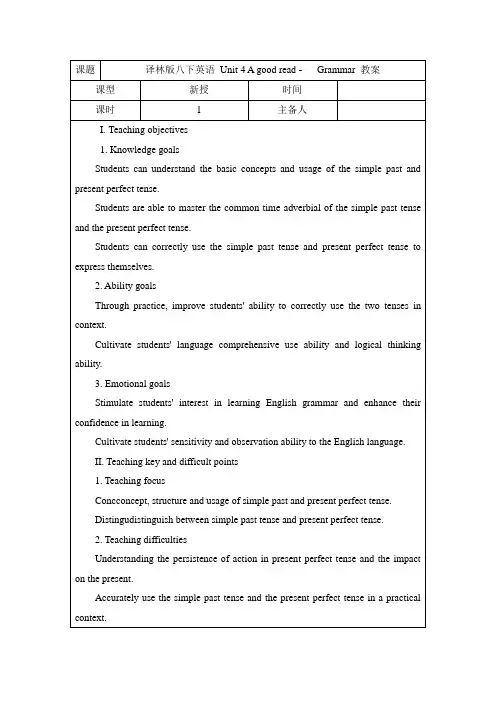
课题译林版八下英语Unit 4 A good read - Grammar 教案课型新授时间课时 1 主备人I.Teaching objectives1. Knowledge goalsStudents can understand the basic concepts and usage of the simple past and present perfect tense.Students are able to master the common time adverbial of the simple past tense and the present perfect tense.Students can correctly use the simple past tense and present perfect tense to express themselves.2. Ability goalsThrough practice, improve students' ability to correctly use the two tenses in context.Cultivate students' language comprehensive use ability and logical thinking ability.3. Emotional goalsStimulate students' interest in learning English grammar and enhance their confidence in learning.Cultivate students' sensitivity and observation ability to the English language.II. Teaching key and difficult points1. Teaching focusConcconcept, structure and usage of simple past and present perfect tense.Distingudistinguish between simple past tense and present perfect tense.2. Teaching difficultiesUnderstanding the persistence of action in present perfect tense and the impact on the present.Accurately use the simple past tense and the present perfect tense in a practical context.III. teaching method1. Teaching method: explain the grammar rules and usage of simple past tense and present perfect tense.2. Practice method: consolidate the knowledge learned through practice and improve students' language use ability.3. Discussion method: Organize students to discuss relevant grammar points to deepen their understanding of knowledge.4. Induction method: guide the students to summarize the characteristics and differences of the two tenses.IV teaching process(1) Lead in (5 minutes)1. Show pictures or videos about events in the past and things that continue to the present, such as "a person went to the park yesterday" and "a person has lived in the city for five years now."2. Ask the students how to describe these situations in English, and guide them to think about different tense expressions.(2) Knowledge explanation (10 minutes)1. Simple past timeConcept: An action or state of existence at a certain time in the past.Structure: subject + verb past formula + other.Time adverbial: yesterday, the other day,last...,...ago et al.For example: I visited the Palace Museum with my grandparents the other day.2. Now is in the perfect tenseConcept: represents the effect or result of past actions on the present, or the action or state that continues from the past to the present.Structure: Subject + has / has + the past participle of the verb + other.Timbial language: already, ever, trust, recently, not yet, so far, up to now, until / till now, etc.For example: Daniel has lived in Beijing for two years.(Iii) Comparative analysis (15 minutes)1. Organize students to compare the usage and time symptoms of simple past tense and present completion tense, and complete the form:Ttense usage time adverbialAction or presence in a simple past state yesterday, the other day,last...,...ago et al Present perfect tense Impact or consequences of past actions on the present; actions or states continuing from the past to the present already, ever, trust, recently, not yet, so far, up to now, until / till now, etc2. Let the students discuss the difference between the two tenses, and the teacher will summarize and supplement them.(4) Practice and consolidation (10 minutes)1. Complete the exercises in the textbook, such as Simon is showing Millie some pictures. Complete his sentences with the correct forms of the words in brackets., etc.2. Give some sentences, let the students judge whether the simple past or the present, and explain why.For example: I saw the film yesterday. (simple past, because there is a clear past time "yesterday")He has finished his homework. (Now finish time, emphasize the impact on the present "work is completed")(V) Expand the application (5 minutes)1. Create a situation for students to have a dialogue between the simple past tense and the present completion tense.For example: A: Have you ever been to5. Teaching reflectionIn this teaching, through the introduction of pictures and videos has stimulated the students' interest in learning, so that the students can quickly enter the learning state. In the link of knowledge explanation, the method of comparative analysis is used to let the students clearly understand the difference and usage of simple past time and present perfect tense. Practice consolidation link, through various forms ofpractice, such as filling in the blanks, judgment, dialogue, etc., to help students to deepen the understanding and mastery of knowledge. Expand the application link, let the students use the knowledge learned in the actual situation, improve the students' comprehensive use of language ability.However, there are also some shortcomings in the teaching process. Some students do not have a thorough understanding of the continuous movements in present perfect tense, and they are easy to make mistakes when using them. In the future teaching, we should strengthen the practice and explanation of this aspect, and give some more vivid examples to help students understand. At the same time, in the design of teaching activities, can be more diversified, increase the group competition and other forms, improve the students' participation and enthusiasm.。
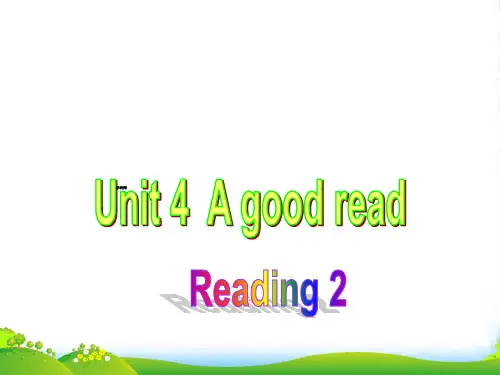
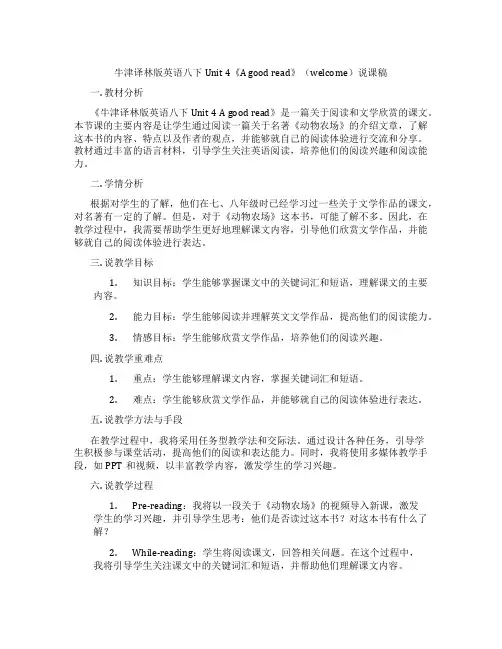
牛津译林版英语八下Unit 4《A good read》(welcome)说课稿一. 教材分析《牛津译林版英语八下Unit 4 A good read》是一篇关于阅读和文学欣赏的课文。
本节课的主要内容是让学生通过阅读一篇关于名著《动物农场》的介绍文章,了解这本书的内容、特点以及作者的观点,并能够就自己的阅读体验进行交流和分享。
教材通过丰富的语言材料,引导学生关注英语阅读,培养他们的阅读兴趣和阅读能力。
二. 学情分析根据对学生的了解,他们在七、八年级时已经学习过一些关于文学作品的课文,对名著有一定的了解。
但是,对于《动物农场》这本书,可能了解不多。
因此,在教学过程中,我需要帮助学生更好地理解课文内容,引导他们欣赏文学作品,并能够就自己的阅读体验进行表达。
三. 说教学目标1.知识目标:学生能够掌握课文中的关键词汇和短语,理解课文的主要内容。
2.能力目标:学生能够阅读并理解英文文学作品,提高他们的阅读能力。
3.情感目标:学生能够欣赏文学作品,培养他们的阅读兴趣。
四. 说教学重难点1.重点:学生能够理解课文内容,掌握关键词汇和短语。
2.难点:学生能够欣赏文学作品,并能够就自己的阅读体验进行表达。
五. 说教学方法与手段在教学过程中,我将采用任务型教学法和交际法。
通过设计各种任务,引导学生积极参与课堂活动,提高他们的阅读和表达能力。
同时,我将使用多媒体教学手段,如PPT和视频,以丰富教学内容,激发学生的学习兴趣。
六. 说教学过程1.Pre-reading:我将以一段关于《动物农场》的视频导入新课,激发学生的学习兴趣,并引导学生思考:他们是否读过这本书?对这本书有什么了解?2.While-reading:学生将阅读课文,回答相关问题。
在这个过程中,我将引导学生关注课文中的关键词汇和短语,并帮助他们理解课文内容。
3.Post-reading:学生将就自己的阅读体验进行交流和分享。
在这个过程中,我将引导学生表达自己的观点,提高他们的表达能力。
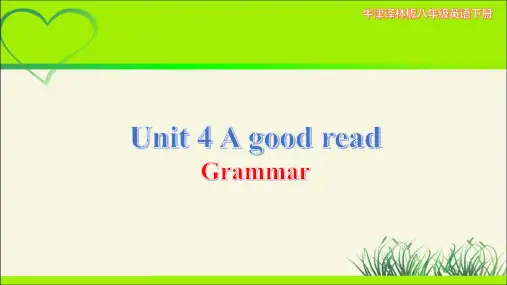
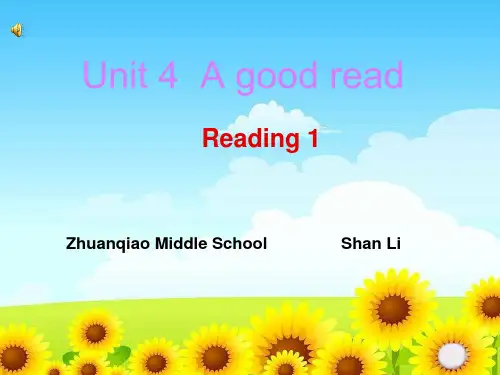
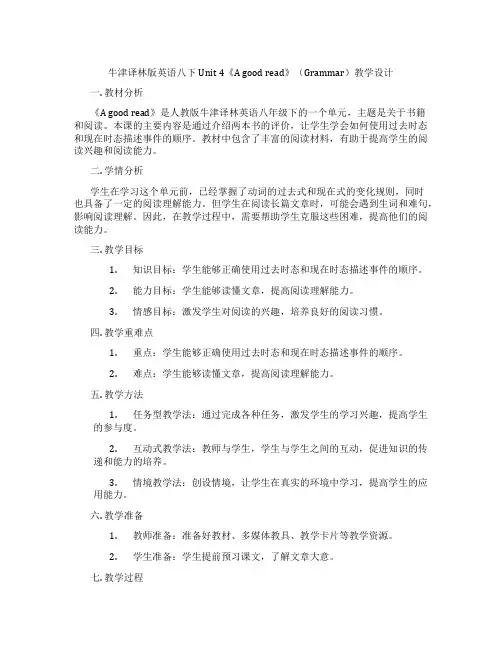
牛津译林版英语八下Unit 4《A good read》(Grammar)教学设计一. 教材分析《A good read》是人教版牛津译林英语八年级下的一个单元,主题是关于书籍和阅读。
本课的主要内容是通过介绍两本书的评价,让学生学会如何使用过去时态和现在时态描述事件的顺序。
教材中包含了丰富的阅读材料,有助于提高学生的阅读兴趣和阅读能力。
二. 学情分析学生在学习这个单元前,已经掌握了动词的过去式和现在式的变化规则,同时也具备了一定的阅读理解能力。
但学生在阅读长篇文章时,可能会遇到生词和难句,影响阅读理解。
因此,在教学过程中,需要帮助学生克服这些困难,提高他们的阅读能力。
三. 教学目标1.知识目标:学生能够正确使用过去时态和现在时态描述事件的顺序。
2.能力目标:学生能够读懂文章,提高阅读理解能力。
3.情感目标:激发学生对阅读的兴趣,培养良好的阅读习惯。
四. 教学重难点1.重点:学生能够正确使用过去时态和现在时态描述事件的顺序。
2.难点:学生能够读懂文章,提高阅读理解能力。
五. 教学方法1.任务型教学法:通过完成各种任务,激发学生的学习兴趣,提高学生的参与度。
2.互动式教学法:教师与学生,学生与学生之间的互动,促进知识的传递和能力的培养。
3.情境教学法:创设情境,让学生在真实的环境中学习,提高学生的应用能力。
六. 教学准备1.教师准备:准备好教材、多媒体教具、教学卡片等教学资源。
2.学生准备:学生提前预习课文,了解文章大意。
七. 教学过程1.导入(5分钟)教师通过提问方式引导学生谈论他们喜欢的书籍和阅读体验,激发学生的学习兴趣。
2.呈现(10分钟)教师通过多媒体展示两本书的评价,让学生听懂并理解文章的内容。
3.操练(15分钟)学生分角色朗读文章,模仿文章中的评价语言。
教师引导学生运用过去时态和现在时态描述事件的顺序。
4.巩固(10分钟)学生分组讨论,总结文章的主旨大意,并用自己的话进行表达。
教师巡回指导,纠正学生的错误。
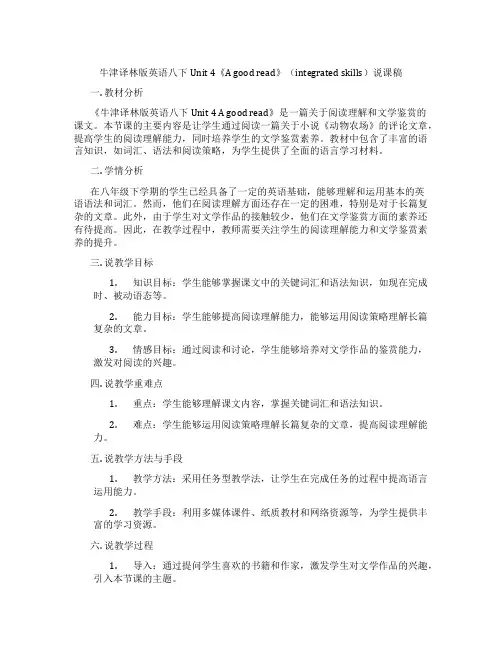
牛津译林版英语八下Unit 4《A good read》(integrated skills)说课稿一. 教材分析《牛津译林版英语八下Unit 4 A good read》是一篇关于阅读理解和文学鉴赏的课文。
本节课的主要内容是让学生通过阅读一篇关于小说《动物农场》的评论文章,提高学生的阅读理解能力,同时培养学生的文学鉴赏素养。
教材中包含了丰富的语言知识,如词汇、语法和阅读策略,为学生提供了全面的语言学习材料。
二. 学情分析在八年级下学期的学生已经具备了一定的英语基础,能够理解和运用基本的英语语法和词汇。
然而,他们在阅读理解方面还存在一定的困难,特别是对于长篇复杂的文章。
此外,由于学生对文学作品的接触较少,他们在文学鉴赏方面的素养还有待提高。
因此,在教学过程中,教师需要关注学生的阅读理解能力和文学鉴赏素养的提升。
三. 说教学目标1.知识目标:学生能够掌握课文中的关键词汇和语法知识,如现在完成时、被动语态等。
2.能力目标:学生能够提高阅读理解能力,能够运用阅读策略理解长篇复杂的文章。
3.情感目标:通过阅读和讨论,学生能够培养对文学作品的鉴赏能力,激发对阅读的兴趣。
四. 说教学重难点1.重点:学生能够理解课文内容,掌握关键词汇和语法知识。
2.难点:学生能够运用阅读策略理解长篇复杂的文章,提高阅读理解能力。
五. 说教学方法与手段1.教学方法:采用任务型教学法,让学生在完成任务的过程中提高语言运用能力。
2.教学手段:利用多媒体课件、纸质教材和网络资源等,为学生提供丰富的学习资源。
六. 说教学过程1.导入:通过提问学生喜欢的书籍和作家,激发学生对文学作品的兴趣,引入本节课的主题。
2.阅读理解:学生自主阅读课文,回答相关问题,教师引导学生运用阅读策略理解文章。
3.词汇语法:学生通过课文学习新词汇和语法知识,教师进行讲解和练习。
4.小组讨论:学生分组讨论课文中的观点和表达方式,培养学生的批判性思维能力。
5.文学鉴赏:教师引导学生分析课文中的文学手法和特点,提高学生的文学鉴赏素养。

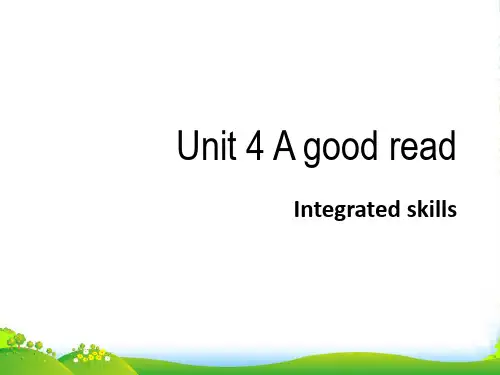
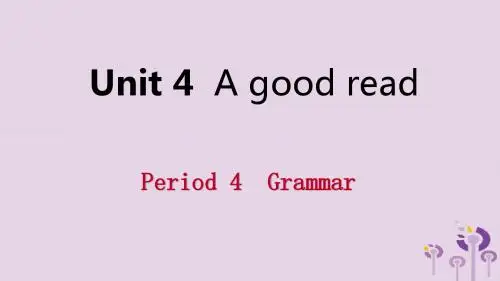
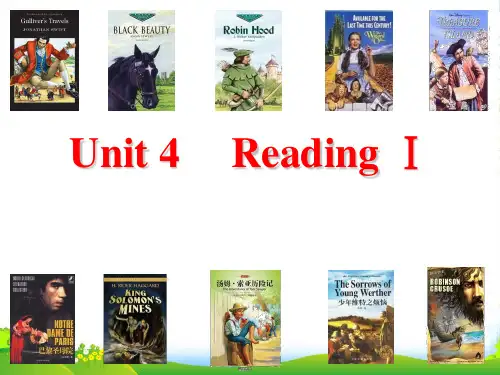
课题译林版八下英语Unit 4 A good read - Grammar 教学设计课型新授时间课时 1 主备人一、教学目标1. 知识目标学生能够理解并掌握一般过去时和现在完成时的基本结构和用法。
学生能够正确区分一般过去时和现在完成时,并在语境中准确运用。
2. 能力目标通过练习和活动,提高学生运用一般过去时和现在完成时进行书面表达和口头交流的能力。
培养学生观察、分析和归纳语言规律的能力。
3. 情感目标激发学生学习英语语法的兴趣,增强学习的自信心。
培养学生在实际生活中运用英语准确表达时间和经历的意识。
二、教学重难点1. 教学重点一般过去时和现在完成时的结构和用法。
一般过去时和现在完成时的时间状语。
区分一般过去时和现在完成时的用法。
2. 教学难点理解现在完成时中动作对现在造成的影响或结果。
掌握一般过去时和现在完成时在语境中的正确运用。
三、教学方法1. 讲授法讲解一般过去时和现在完成时的概念、结构和用法,让学生对两种时态有初步的了解。
2. 对比法通过对比一般过去时和现在完成时的句子,引导学生发现它们的差异,加深对两种时态的理解。
3. 练习法设计多种形式的练习题,如填空、选择、造句等,让学生在实践中巩固所学知识,提高运用能力。
4. 情景教学法创设真实的语言情景,让学生在具体的情境中感受和运用一般过去时和现在完成时,增强语言的实用性。
四、教学过程(一)导入(5 分钟)1. 教师与学生进行简单的日常问候,然后通过提问引导学生回忆过去的经历。
例如:“Did you have a great weekend? What did you do last weekend?”2. 展示一些与过去活动相关的图片,如旅行、聚会等,让学生用一般过去时描述图片中的内容。
例如:“I went to the park last Sunday. We had a party yesterday.”(二)语法讲解(10 分钟)1. 一般过去时展示一些一般过去时的句子,如“Daniel went to Beijing two years ago.” “I visited the Palace Museum the other day.” 引导学生观察句子结构,总结一般过去时的构成:主语+ 动词的过去式+ 其他。
Unit 4 A good read第四课时Integratedskills&Studyskills基础知识回顾Ⅰ.根据首字母及汉语提示补全单词1.Talent and hard work lead to success (成功).2.—Can you translate (翻译) these English sentences into Chinese?—Of course.3.Mr White asked me to send a copy (一份) of the report to him.4.Why did the patient refuse (拒绝) to take the medicine?5.Amy has collected much experience (经验) in teaching History.Ⅱ.根据句意用所给词的适当形式填空1.You should read some reviews (review) about the film before watching it.2.I’d like to renew (new) these library books.3.A publishing (publish) house is a company which publishes books.4.This great novel has lost something in translation (translate).st summer,I went to Canada and I found the Canadians are very friendly and helpful.(Canada)Ⅲ.用方框中所给短语的适当形式填空search for,on the other hand,at a time,be willing to,on time1.Don’t try to do everything at once.Take it a bit at a time .2.Do you think you’ll get the work finished on time ?3.Can you help me(to) search for my key?4.I am willing to work for the good of the people.5.On the one hand,I have to work.On the other hand ,I have many visitors to see.Ⅳ.根据汉语意思完成句子,每空一词1.你不需要来我们图书馆,在网上续借它们就可以了。
You don’t have to come to our library.Just renew themonline .2.我一次可以借几本书?可以借多长时间?How many books can I borrow at a time?And how long can I keep them ?3.到目前为止,他们还没有决定好如何处理这些废料。
So far ,they haven’t decided what/how to do/deal with the waste.4.《金银岛》讲述了一个小男孩在海上航行,寻找隐藏的财富的故事。
TreasureIsland tells the story of a young boy who sailed the sea to look for hidden treasure .5.有可能我长大了也能成为一个作家!Maybe I can become a writer when I grow up!综合能力提升Ⅰ.单项填空(A)1.Nick is never late for work.He always gets to the office.A.on timeB.in timeC.at timesD.at a time(B)2.He is businesslike(务实的) and is often.I hope he will have moreat his business.A.success;successfulB.successful;successC.successfully;successfulD.successful;successful(D)3.They invited me to play football,but I had to because I was very busy.A.standB.affordC.spendD.refuse(B)4.—Could you tell me it takes to walk to the Disneyland?—About 20 minutes.A.how farB.how longC.how oftenD.how soon(A)5.He has much as an engineer.So he is the best person to design and build the bridge.A.experienceB.balanceC.serviceD.advice(C)6.We need clear air and water,so we protect the environment.A.canB.mayC.mustD.might(A)7.—Could you me your bike,Tom?—OK.And you can it for a week.A.lend;keepB.borrow;lendC.lend;borrowD.borrow;keep(D)8.You take me to the station.My brother’s taking me.A.can’tB.mustn’tC.shouldn’tD.don’t have to(A)st night,the shop was closed,she didn’t buy any chocolate.A.soB.ifC.orD.when(B)10.—You gave me a lot of help.Thank you.—.A.Don’t tha nk meB.You’re welcomeC.Don’t say soD.This is what I should doⅡ.补全对话Jim:The weekend is coming.What are we going to do?Mary:1. D We could go to the countryside.Jim:Actually,I don’t really want to go out of town.2. AMary:Sure.What book would you like to read?Jim:JourneytotheWest.Mary:I love that book.It’s really a Chinese classic.You know the Chinese have made a whole TV play about it.3. FJim:Yeah.I’ve seen it too.4. BMary:I’ll go with you to the library tomorrow.Jim:That’s great.5.GM ary:OK.I’ll buy some beautiful dresses for summer.Ⅲ.阅读理解Dictionary is very important for our study.What can we find when we use an English-Chinese or an English-English dictionary?Definition(释义).The first thing in a dictionary that people think of is definition.A word sometimes has more than one definition.We should choose a proper one according to our need.Spelling.If you are not sure about the correct spelling of one word,you can look it up in a dictionary.Dictionaries have guide e the guide words,and you can find the word you are looking for easily.Pronunciation.You can know the correct pronunciations of words by looking up the dictionary.There are British and American pronunciations.You can choose either of them.Otherusefulinformation.Some useful information can be found in the appendixes of the dictionary as well,such as weights and measures(度量衡表),maps,geographical names,irregular verbs and so on.They are usually at the end of a dictionary.(C)1.What’s the first thing in a dictionary that peopl e think of?A.Spelling.B.Pronunciation.C.Definition.eful information.(D)2.What’s the meaning of the underlined word “appendixes” in Chinese?A.前言B.目录C.正文D.附录(D)3.What’s the main idea of the passage?A.How to use an English-Chinese or an English-English dictionary.B.The differences between an English-Chinese dictionary and an English-English dictionary.C.The importance of using an English-Chinese or an English-English dictionary.D.What you can find in an English-Chinese or an English-English dictionary.欢迎您的下载,资料仅供参考!。